alaska
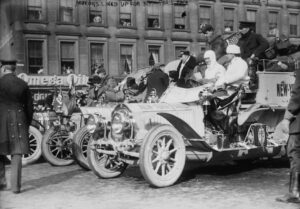
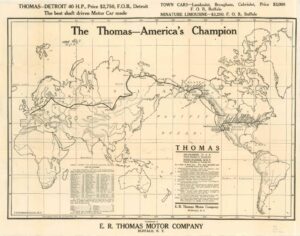 A car race is most often run on a track, with lots of fans cheering everyone on, but in 1908, there was a very strange car race that actually used a track that took the drivers around the world!! How…you might ask?? Well, the car race started in New York City. From there the route took the racers to San Francisco. Normally, San Francisco would be the end of the trail…or the route. You would have reached the Pacific Ocean, and as we all know, cars can’t drive on the ocean…especially cars manufactured in 1908. So, the racers turned to the north and headed for Valdez, Alaska. They would arrive in Valdez in the height of winter…at a time when the Bering Strait was frozen over…theoretically. At that point there was supposed to be an ice bridge across the Bering Strait, making it possible for the cars to drive right over it and into Russia. Once across, the racers would continue on from Russia to Europe and the finish line awaiting them in Paris. It’s amazing to me to think about cars being driven around the world, but of course the Bering Strait in the Winter, supposedly changed everything. In 1908, cars were relatively new, so road infrastructure was limited to only metropolitan areas, and even then, a lot of it was cobbled stone. So, I suppose cross country car travel on dirt trails was not that uncommon.
A car race is most often run on a track, with lots of fans cheering everyone on, but in 1908, there was a very strange car race that actually used a track that took the drivers around the world!! How…you might ask?? Well, the car race started in New York City. From there the route took the racers to San Francisco. Normally, San Francisco would be the end of the trail…or the route. You would have reached the Pacific Ocean, and as we all know, cars can’t drive on the ocean…especially cars manufactured in 1908. So, the racers turned to the north and headed for Valdez, Alaska. They would arrive in Valdez in the height of winter…at a time when the Bering Strait was frozen over…theoretically. At that point there was supposed to be an ice bridge across the Bering Strait, making it possible for the cars to drive right over it and into Russia. Once across, the racers would continue on from Russia to Europe and the finish line awaiting them in Paris. It’s amazing to me to think about cars being driven around the world, but of course the Bering Strait in the Winter, supposedly changed everything. In 1908, cars were relatively new, so road infrastructure was limited to only metropolitan areas, and even then, a lot of it was cobbled stone. So, I suppose cross country car travel on dirt trails was not that uncommon.
The Great Race of 1908 began on February 3rd of that year and immediately ran into challenges. Just to list a few…cars breaking down multiple times, lack of usable roads, car-hating people giving wrong directions, and, oh yeah, SNOW!!! Nevertheless, the teams persevered, and the first team reached San Francisco in 41 days. The came the obstacle of the fact that the proposed route from San Francisco to Alaska did not exist. I guess that they didn’t think it would be feasible to create the route, so the race organizers allowed teams to ship their cars to Valdez, Alaska, then continue on the Ice Bridge. Some might have called that a bit of a cheat, but I guess if all the racers id it, it wasn’t really cheating. Once in Valdez, the teams found out that there is, in fact, no ice bridge across the Bering Strait anymore, because it melted about 20,000 YEARS AGO. Oops…small oversight. So, the racers were allowed to ship their cars across the Pacific to Japan, then Russia, to carry on. Ok, if you’re like me, at this point, you are starting to see that this race had a lot of flaws in the planning. And honestly, while I knew there was no ice bridge on the Bering Strait today, I was unaware that it melted that long ago…meaning there was not an ice bridge since the “Ice Age!!”
So, was this really a car race around the world or a whole lot of non-sense. To be sure, the six teams did end up in Paris after the race, and they drove all of the route that could be driven, but the reality is that much of the race was simply cars being transported by ships across the ocean. Nevertheless, the “official” race was documented as just that…a car race that went around the world. The cars had to fight mud, snow, and mechanical problems. It was “officially” won by The Thomas Flyer, built by the Thomas Motor Company, was a 1907 Model 35 with a 4-cylinder, 60-horsepower engine capable of reaching 60 mph. It was fully loaded with two shovels, two picks, two lanterns, eight searchlights, two extra gas tanks (with a capacity of ten gallons), five hundred feet of rope, a rifle and revolvers. It was also equipped with an attachable top…much like those used on covered wagons…that could wrap the entire car and offer an enclosed place to sleep. On July 30, after 169 days of travel, the Thomas car entered Paris. Even in Paris, they almost didn’t finish, because a police 
 officer stopped the vehicle, saying it had no working headlight, and couldn’t proceed. A passing bicyclist witnessed the scene and offered to load his bike into the car. Since the bicycle had a working headlight, the officer allowed them to pass. The Thomas Flyer finally finished at 6:00pm. The race was the only “official” car race around the world.
officer stopped the vehicle, saying it had no working headlight, and couldn’t proceed. A passing bicyclist witnessed the scene and offered to load his bike into the car. Since the bicycle had a working headlight, the officer allowed them to pass. The Thomas Flyer finally finished at 6:00pm. The race was the only “official” car race around the world.
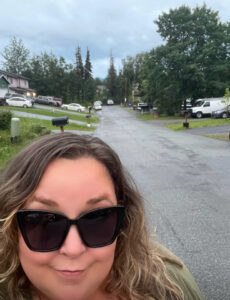
 My niece, Michelle Miller has had a busy year this year. She and her husband, Matt love the outdoors, and had done some camping before, but this year they bought a “new to them” fifth wheel from Michelle’s Aunt Kathy and Uncle Mike. The trailer is pretty big and gives them all the comforts they could want. They really love it, and they have gone camping this year, more than ever before. They are both very busy people, and being able to get away is so important, so I am very happy for them.
My niece, Michelle Miller has had a busy year this year. She and her husband, Matt love the outdoors, and had done some camping before, but this year they bought a “new to them” fifth wheel from Michelle’s Aunt Kathy and Uncle Mike. The trailer is pretty big and gives them all the comforts they could want. They really love it, and they have gone camping this year, more than ever before. They are both very busy people, and being able to get away is so important, so I am very happy for them.
In July, the whole Miller family went to Alaska for Matt’s brother, Mikey’s birthday. It was a wonderful trip, and Michelle loved Alaska. I think that is how everyone feels about Alaska, me included. Mikey has a sailboat, and they got to go out in it a few times and really enjoyed it. Being the sporting family they are, they did a lot of fishing, and of course, eating the fish they caught. Since they were a big group, they rented an RV, so they could do a lot of camping and sightseeing. Michelle especially loved the mountains and overall scenery of Alaska. The 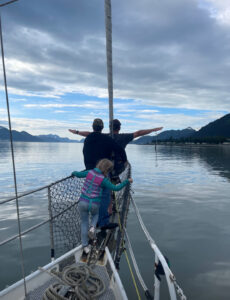
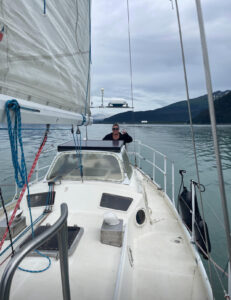 mountains are so majestic. Everything seems huge in Alaska. You discover how small humans are in comparison.
mountains are so majestic. Everything seems huge in Alaska. You discover how small humans are in comparison.
On October 28, her sister, Lacey got married, and Michelle was one of the bridesmaids. The wedding was beautiful, and everyone looked so elegant. Michelle was so happy for her sister, and the wedding preparation went perfectly. The bachelorette weekend was held in Nashville at the end of September, and Michelle really pampered her sister. Everyone had so much fun. Michelle helped in any way that she could to ensure that the wedding went smoothly and that it was Lacey’s dream wedding.
Michelle has been really busy at The Nic (The Nicolaysen Art Museum) where she works, but she has found time to get back into doing her own art, and Michelle is an amazing artist, so I’m glad that her talent has been able to blossom again. She has also been doing a lot of sewing. I didn’t know she could sew, and I am amazed at anyone who can. I’ve sewed some things, but I would 
 not call myself a seamstress. Michelle really loves both activities. Michelle and her husband also have two fur babies…puppies Obie and Leia. They truly are her babies, and she loves to spoil them terribly, but that is what people do with their fur babies, after all. Michelle even has a nanny cam so she can see them and talk to them while she’s at work. Now, that’s love…they can’t be lonely, right!! Good job fur momma!! Today is Michelle’s birthday. Happy birthday Michelle!! Have a great day!! We love you!!
not call myself a seamstress. Michelle really loves both activities. Michelle and her husband also have two fur babies…puppies Obie and Leia. They truly are her babies, and she loves to spoil them terribly, but that is what people do with their fur babies, after all. Michelle even has a nanny cam so she can see them and talk to them while she’s at work. Now, that’s love…they can’t be lonely, right!! Good job fur momma!! Today is Michelle’s birthday. Happy birthday Michelle!! Have a great day!! We love you!!

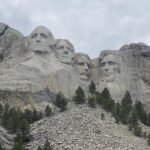 Thanksgiving…a day of reflection on the events of the year that has passed and the blessings we have been given. Many people think of Thanksgiving as just a day to eat a big meal, and watch the parade or a football game, but that isn’t its real purpose at all. None of us goes through life without trials and troubles, but by the grace of God, we have come through another year, and that is something to be thankful for, even if your year had very few trials.
Thanksgiving…a day of reflection on the events of the year that has passed and the blessings we have been given. Many people think of Thanksgiving as just a day to eat a big meal, and watch the parade or a football game, but that isn’t its real purpose at all. None of us goes through life without trials and troubles, but by the grace of God, we have come through another year, and that is something to be thankful for, even if your year had very few trials.
We have been very blessed this past year. Our daughter, Corrie Petersen graduated from nursing school, and we got to go to Las Vegas for her graduation ceremony and spend a week there celebrating. We had a wedding for Athena and Josh, and anniversary for Karen and Chris, and two new great grandsons, Axel and Cyler arrive…to join the great granddaughter, Cambree (who started Kindergarten this year) and two great grandsons, Caysen and Justin, that we already had. My daughter, Amy and her daughter, Shai came out from Washington for the wedding. I also got to go out and spend two wonderful weeks with Amy and her family, Travis, Shai, and Caalab in Washington state. Amy and Shai changed jobs, moving from Rice Insurance to Brown and Brown Insurance. Amy and Travis also got to finally take their anniversary cruise to Alaska. They had a great time, and even got to see the Aurora Borealis. 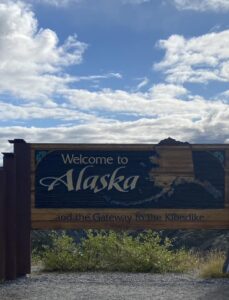
 It was a good move for them. Bob and I spent a relaxing week in the Black Hills, as well as our anniversary trip to Thermopolis, which are two of our favorite places.
It was a good move for them. Bob and I spent a relaxing week in the Black Hills, as well as our anniversary trip to Thermopolis, which are two of our favorite places.
As with any year, there were a few tougher times, but they were few and far between. All in all, our year was awesome, and we can honestly say that God has greatly blessed our family. As we celebrate the blessings of God, I want to give thanks to Him who is the Father of all blessings. We would not be where we are without our gracious God. We have been healed of all our infirmities and strengthened for all we have undertaken. Our God is truly an awesome God!! I pray that everyone had a year filled with God’s greatest blessings. Happy Thanksgiving to all of my family and friends! God bless your next year! I love you all!
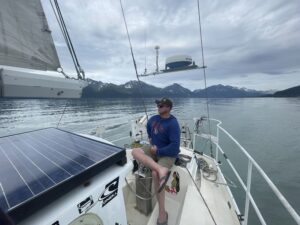
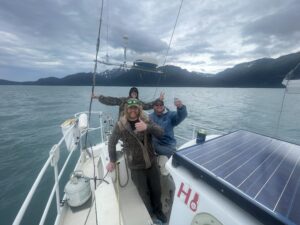 My nephew, Matt Miller joined our family when he married my niece, Michelle (Stevens) Miller on August 14, 2021. They had been best friends since junior high, and later they knew that theirs was far more than a friendship…it was forever. Since their marriage, they have had many amazing times, and things just keep getting better. This year, Matt was promoted to shovel operator at the North Antelope Rochelle Mine where he works. He has really been enjoying that.
My nephew, Matt Miller joined our family when he married my niece, Michelle (Stevens) Miller on August 14, 2021. They had been best friends since junior high, and later they knew that theirs was far more than a friendship…it was forever. Since their marriage, they have had many amazing times, and things just keep getting better. This year, Matt was promoted to shovel operator at the North Antelope Rochelle Mine where he works. He has really been enjoying that.
Matt’s brother, Mikey lives in Soldotna, Alaska, and the Miller family decided to make a trip to visit. The whole 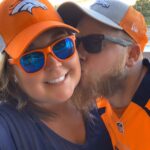 family went, and they all had a great time. Mikey has a sailboat, and with Alaskan fishing what it is, well you know they had to go fishing. Just going to Alaska is an amazing trip, as anyone who has been there can tell you. Now I don’t know if I would be one to live there year-round, but I would like to see both extremes…the sun that never sets, and the sun that never rises. With family living up there, Matt and Michelle might have that opportunity, which I think is very cool. While they were in Alaska, that sailboat called their name on a regular basis. For Michelle, going out on the sailboat was incredible. The views were amazing, and she could just relax and enjoy, and the boys did LOTS of fishing. Matt caught a huge ling cod! He and Michelle came home with a bunch of salmon too. Of course, they didn’t spend all their time fishing, or at least I hope they didn’t, because Alaska has lots of stunning views, and since it was July, they had plenty of daylight hours to explore, and even into the nighttime,
family went, and they all had a great time. Mikey has a sailboat, and with Alaskan fishing what it is, well you know they had to go fishing. Just going to Alaska is an amazing trip, as anyone who has been there can tell you. Now I don’t know if I would be one to live there year-round, but I would like to see both extremes…the sun that never sets, and the sun that never rises. With family living up there, Matt and Michelle might have that opportunity, which I think is very cool. While they were in Alaska, that sailboat called their name on a regular basis. For Michelle, going out on the sailboat was incredible. The views were amazing, and she could just relax and enjoy, and the boys did LOTS of fishing. Matt caught a huge ling cod! He and Michelle came home with a bunch of salmon too. Of course, they didn’t spend all their time fishing, or at least I hope they didn’t, because Alaska has lots of stunning views, and since it was July, they had plenty of daylight hours to explore, and even into the nighttime, 
 when the sun barely sets. That is really very cool!!
when the sun barely sets. That is really very cool!!
Matt went elk hunting on the opening day of archery hunting the year. He got a really nice elk, on that first day. That isn’t something that always happen, and Matt was very excited about that. Matt loves hunting, fishing, and any other form of outdoor sports. He also loves to watch sports, and this year has been a banner year…except for the Broncos. Matt is a Broncos fan, and he as it has been for all of the Broncos fans (I’m one), their losing streak has been extremely disappointing. The good news is that things appear to be looking up. I guess we will see how the rest of the season goes. Today is Matt’s birthday. Happy birthday Matt!! Have a great day!! We love you!!

 While their 25th anniversary was three years ago, my daughter, Amy Royce and her husband Travis Royce are heading out today on their 28th anniversary to celebrate their 25th anniversary, which just so happened to land in the middle of the Covid-19 pandemic. They had wanted to take a cruise to Alaska for their 25th anniversary, but the cruise ships weren’t sailing then. Now they are, and the ridiculous restrictions are gone, so off they go to have the trip of a lifetime, and I am so excited for them. Since Amy’s dad and I took an Alaskan cruise and absolutely loved every minute of it, I can’t wait for them to experience the same amazing trip we did.
While their 25th anniversary was three years ago, my daughter, Amy Royce and her husband Travis Royce are heading out today on their 28th anniversary to celebrate their 25th anniversary, which just so happened to land in the middle of the Covid-19 pandemic. They had wanted to take a cruise to Alaska for their 25th anniversary, but the cruise ships weren’t sailing then. Now they are, and the ridiculous restrictions are gone, so off they go to have the trip of a lifetime, and I am so excited for them. Since Amy’s dad and I took an Alaskan cruise and absolutely loved every minute of it, I can’t wait for them to experience the same amazing trip we did.
Amy and Travis are so perfect for each other. They are both funny and they like many of the same things. They  don’t get stressed or bent out of shape about things, but rather they pretty much go with the flow of life. I think that’s a big part of why their marriage works so well. In a number of ways, they remind me of how my parents and grandparents were with each other. From pet names to the way they think, they just fit in with that same easy compatibility that my parents and grandparents had. It’s funny how some couples can immediately seem like they have been married for decades, and it just gets better and better as the years go by. Amy and Travis are like that. I love the pet names especially, although I won’t tell them here, because that is their names for each other, and not for anyone else to use.
don’t get stressed or bent out of shape about things, but rather they pretty much go with the flow of life. I think that’s a big part of why their marriage works so well. In a number of ways, they remind me of how my parents and grandparents were with each other. From pet names to the way they think, they just fit in with that same easy compatibility that my parents and grandparents had. It’s funny how some couples can immediately seem like they have been married for decades, and it just gets better and better as the years go by. Amy and Travis are like that. I love the pet names especially, although I won’t tell them here, because that is their names for each other, and not for anyone else to use.
Amy and Travis lived in Wyoming while they raised their children, but then moved to Washington state in 2004. They do love it there, and it is beautiful. Of course, we miss them, because we don’t get to see them very much, but going for visits is always a great treat. They have a beautiful place up in the Ferndale area and they 
 love fixing up the yard with flowers and turning it into an oasis. They are so happy with their home, and they love to entertain family and friends there. They have a garage/recreation room that has been turned into the T&Avern, which is their own private club. They have a pool table in there and you might even get to listen to Tavis and Caalab play guitars, while Shai sings. Caalab and Shai are their two grown kids. For Amy and Travis, it’s an ideal life. Today is their 28th Anniversary. Happy anniversary on the Royal Princess!! Have a wonderful time!! We love you!!
love fixing up the yard with flowers and turning it into an oasis. They are so happy with their home, and they love to entertain family and friends there. They have a garage/recreation room that has been turned into the T&Avern, which is their own private club. They have a pool table in there and you might even get to listen to Tavis and Caalab play guitars, while Shai sings. Caalab and Shai are their two grown kids. For Amy and Travis, it’s an ideal life. Today is their 28th Anniversary. Happy anniversary on the Royal Princess!! Have a wonderful time!! We love you!!
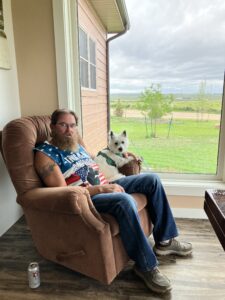
 My brother-in-law, Mike Reed doesn’t always spend his birthday with the guys, but when he does, he really does it up right. This year, doing it up right meant a brothers and brothers-in-law trip to Seward, Alaska to go fishing, and boy…did they go fishing!! The “gang” included Mike’s brothers, Tim and Shawn Reed; brothers-in-law, Mike Stevens and Kevin Forbis; as well as Mike’s nephew, Josh Reed (Shawn’s son). Their trip started with a drive from Casper, Wyoming to Denver, Colorado. After a short night in a hotel, the headed to a very busy Denver International Airport at 3:30 in the morning…finally arriving at their gate at 5:20am for a 6:00am flight to Seattle. Then it was on to Anchorage where they rented a car and drove to Seward and finally got to relax in their Airbnb.
My brother-in-law, Mike Reed doesn’t always spend his birthday with the guys, but when he does, he really does it up right. This year, doing it up right meant a brothers and brothers-in-law trip to Seward, Alaska to go fishing, and boy…did they go fishing!! The “gang” included Mike’s brothers, Tim and Shawn Reed; brothers-in-law, Mike Stevens and Kevin Forbis; as well as Mike’s nephew, Josh Reed (Shawn’s son). Their trip started with a drive from Casper, Wyoming to Denver, Colorado. After a short night in a hotel, the headed to a very busy Denver International Airport at 3:30 in the morning…finally arriving at their gate at 5:20am for a 6:00am flight to Seattle. Then it was on to Anchorage where they rented a car and drove to Seward and finally got to relax in their Airbnb.
Three days of fishing began the next morning with a great haul. The guys had a wonderful time talking and fishing, and it looks like everyone caught fish. There were some extra big fish, which is common in Alaskan waters, and I’m sure the guys loved them. Catching a big fish is always challenging and very cool. When you 
 get them in the boat, you know that you have accomplished something. I’m not a fisherman, but I know a lot of people who find great satisfaction is fishing, and most of my brothers-in-law are among those people. So, Mike and the gang are out having a guys’ week, doing one of the things they really love…fishing.
get them in the boat, you know that you have accomplished something. I’m not a fisherman, but I know a lot of people who find great satisfaction is fishing, and most of my brothers-in-law are among those people. So, Mike and the gang are out having a guys’ week, doing one of the things they really love…fishing.
Mike works really hard. He and my sister, Caryl Reed own a ranch on the west side of Casper, where they grow oats, while they work their way into a good form of hay. They have a huge irrigation system, and Mike goes out there and wrestles that sprinkler system around to take good care of their crop. Crops like these can’t be left to chance. There is a specific way to grow these, and a process that leads up to producing hay. I did not know that, and quite possibly, Mike and Caryl didn’t either…but they are learning. Mike has purchased a tractor, and whatever else was needed to run their ranch successfully, and has embraced the process of being a rancher, 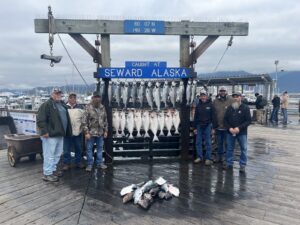
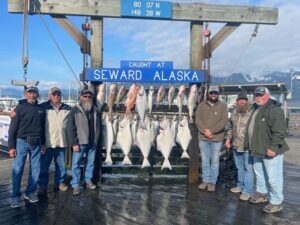 and we are quite proud of his progress. They don’t raise animals right now, but no one knows what the future might bring. Mike and Caryl are both retired now, so they can do anything they want to, including travel. For now, they are enjoying life to the fullest and for Mike, that means occasional hunting and fishing trips too. Today is Mike’s birthday. Happy birthday Mike!! I hope you and the guys are having a blast!! Have a great day!! We love you!!
and we are quite proud of his progress. They don’t raise animals right now, but no one knows what the future might bring. Mike and Caryl are both retired now, so they can do anything they want to, including travel. For now, they are enjoying life to the fullest and for Mike, that means occasional hunting and fishing trips too. Today is Mike’s birthday. Happy birthday Mike!! I hope you and the guys are having a blast!! Have a great day!! We love you!!
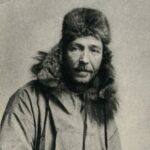
 As a hiker, I can relate to the draw of a mountain peak, but I was never one to do the winter-ice-climbing-up-a-solid-rock-face type of hiker. I like trail hiking personally, but there are many people who would disagree with me on that. One such hiker/climber was Hudson Stuck, an Alaskan missionary, who on June 7, 1913, led the first successful ascent of Denali…also known as Mount McKinley, before they changed the name. Denali, at 20,320 feet is the highest on the American continent. In fact, there are planes that don’t fly that high…small planes, but nevertheless, they don’t go that high, and would have to fly around Denali.
As a hiker, I can relate to the draw of a mountain peak, but I was never one to do the winter-ice-climbing-up-a-solid-rock-face type of hiker. I like trail hiking personally, but there are many people who would disagree with me on that. One such hiker/climber was Hudson Stuck, an Alaskan missionary, who on June 7, 1913, led the first successful ascent of Denali…also known as Mount McKinley, before they changed the name. Denali, at 20,320 feet is the highest on the American continent. In fact, there are planes that don’t fly that high…small planes, but nevertheless, they don’t go that high, and would have to fly around Denali.
Not crazy enough to try Denali solo, Stuck recruited Harry Karstens, a respected guide, to join his expedition as co-leader. Other members were Walter Harper and Robert G Tatum, both 21, and two student volunteers from the mission school, John Fredson and Esaias George. They departed from Nenana on March 17, 1913. They reached the summit of Denali on June 7, 1913…nearly three months later. Harper, who was of mixed Alaska Native and Scots descent, reached the summit first. Fredson, who was just 14, acted as their base camp manager, hunting caribou and Dall sheep to keep them supplied with food.
There is snow on the mountain year-round, and the air up there is thin, requiring some climbers to bring oxygen. Experienced climbers might be able to climb Denali without oxygen, but sometimes, no matter how fit the body, it can fall victim to the effects of low oxygen…fatigue, hyperventilation, fainting, or worse. So, whether it is needed or not, oxygen is a good idea to have on the trek.
Stuck, who was born in London on November 4, 1863, is an accomplished amateur mountaineer. Mountain climbing, like hiking is an addictive passion, once it takes hold of a person. The feeling you get when you are out there, pushing yourself to new heights or longer hikes, simply can’t be matched in any gym. After moving to the United States, in 1905 Stuck became archdeacon of the Episcopal Church in Yukon, Alaska. His treks across Alaska’s difficult terrain were to preach to villagers and establish schools. His climbing of Denali was more a personal goal than a church oriented one. Stuck was an adventure-seeker, and it was that spirit that drove him to higher heights in every area of his life. And it was that spirit that drove him to the mountain tops…maybe to worship God there too. He was a missionary, after all.
Mount McKinley National Park was established as a wildlife refuge in 1917. Harry Karstens served as the park’s first superintendent. In 1980, the park was expanded and renamed Denali National Park and Preserve. 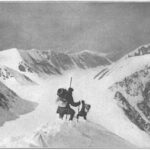
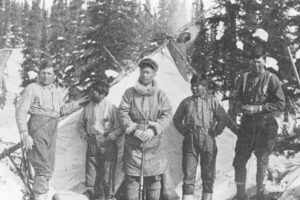 Encompassing 6 million acres, the park is larger than Massachusetts. In 2015, the mountain was officially renamed Denali. Hudson Stuck died of bronchial pneumonia at Fort Yukon, in his beloved Alaska on October 10, 1920. He was 56 years old. At his request, Stuck, still a British citizen is buried in the local cemetery at Fort Yukon. Today, over 1,000 hopeful climbers attempt to scale Denali each year, with about half of them successfully reaching their goal.
Encompassing 6 million acres, the park is larger than Massachusetts. In 2015, the mountain was officially renamed Denali. Hudson Stuck died of bronchial pneumonia at Fort Yukon, in his beloved Alaska on October 10, 1920. He was 56 years old. At his request, Stuck, still a British citizen is buried in the local cemetery at Fort Yukon. Today, over 1,000 hopeful climbers attempt to scale Denali each year, with about half of them successfully reaching their goal.
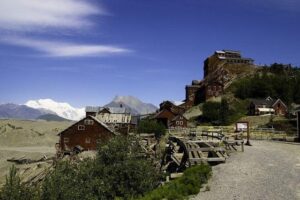 When the minerals in a mine run out, or become less valuable, the mine tends to close down. These days, they try to return the mine to it’s prior state, but then many mines these days are pit mines, or strip mines. I suppose it is easier to return them to their prior state when you only have to fill in the hole, and I’m not opposed to that process. It can make a beautiful place out of ground that has been ripped apart. In some cases, it looks better after the reclamation.
When the minerals in a mine run out, or become less valuable, the mine tends to close down. These days, they try to return the mine to it’s prior state, but then many mines these days are pit mines, or strip mines. I suppose it is easier to return them to their prior state when you only have to fill in the hole, and I’m not opposed to that process. It can make a beautiful place out of ground that has been ripped apart. In some cases, it looks better after the reclamation.
The Kennecott Mine, often spelled Kennicott, is an abandoned mining camp in the Valdez-Cordova Census Area, which is now the Copper River Census Area in the state of Alaska. The mine was, at one time, the center of activity for several copper mines. Kennecott Mines was named after the Kennicott Glacier in the valley below. The geologist Oscar Rohn named the glacier after Robert Kennicott during the 1899 US Army Abercrombie Survey. A “clerical error” resulted in the substitution of an “e” for the “i,” supposedly by Stephen Birch himself. The mine is located northeast of Valdez, inside Wrangell-Saint Elias National Park and Preserve. The camp and mines are now a National Historic Landmark District administered by the National Park Service. It was declared a National Historic Landmark in 1986. It’s status as a historical site, probably explains the good shape it is in. Many historical sites deteriorate badly before anyone realizes that they should be preserved as a part of history.
Two prospectors, “Tarantula” Jack Smith and Clarence L Warner, who were with a group of prospectors associated with the McClellan party in the summer of 1900, spotted “a green patch far above them in an  improbable location for a grass-green meadow.” Upon inspection, the green turned out to be malachite, located with chalcocite…aka “copper glance,” and the location of the Bonanza claim. A few days later, Arthur Coe Spencer, US Geological Survey geologist also found chalcocite at the same location. It was the birth of a copper mine.
improbable location for a grass-green meadow.” Upon inspection, the green turned out to be malachite, located with chalcocite…aka “copper glance,” and the location of the Bonanza claim. A few days later, Arthur Coe Spencer, US Geological Survey geologist also found chalcocite at the same location. It was the birth of a copper mine.
A mining engineer just out of school, named Stephen Birch was in Alaska looking for investment opportunities in minerals. He was young, but he came with the financial backing of the Havemeyer Family and another investor named James Ralph, from his days in New York. Birch spent the winter of 1901-1902 acquiring the “McClellan group’s interests” for the Alaska Copper Company of Birch, Havemeyer, Ralph and Schultz, later to become the Alaska Copper and Coal Company. He spent the summer of 1901, visiting the property and “spent months mapping and sampling.” He confirmed the Bonanza mine and surrounding deposits, were at the time, the richest known concentration of copper in the world.
Kennecott had five mines: Bonanza, Jumbo, Mother Lode, Erie, and Glacier. “Glacier, which is really an ore extension of the Bonanza, was an open-pit mine and was only mined during the summer. Bonanza and Jumbo were on Bonanza Ridge about 3 miles from Kennecott. The Mother Lode mine was located on the east side of the ridge from Kennecott. The Bonanza, Jumbo, Mother Lode and Erie mines were connected by tunnels. The Erie mine was perched on the northwest end of Bonanza Ridge overlooking Root Glacier about 3.7 miles up a glacial trail from Kennecott.” The copper ore was transported to Kennecott by way of the trams which head-ended at Bonanza and Jumbo. From Kennecott the ore was hauled mostly in 140-pound sacks on steel flat cars  to Cordova, 196 rail miles away on the Copper River and Northwestern Railway (CRNW).
to Cordova, 196 rail miles away on the Copper River and Northwestern Railway (CRNW).
In 1925 a Kennecott geologist predicted that the end of the high-grade ore bodies was in sight. The mines days were numbered. The highest grades of ore were largely depleted by the early 1930s. The Glacier Mine closed in 1929, and the rest followed soon after. The last train left Kennecott on November 10, 1938. It was now a ghost town. Over a period of 20 years the population dropped from 494 in 1920 to 5 in 1940. Thankfully the historical value of this particular site was not lost, and is still there today.
 As one who loves to hike, I am always interested in a new trail, whether I will ever get to hike that trail or not. The Chilkoot Trail is a 33 mile trail that travels through the Coast Mountains. The trail travels from Dyea, Alaska, in the United States, to Bennett, British Columbia, in Canada. During the Klondike Gold Rush (1896–1899), the Chilkoot Trail was transformed into a mainstream transportation route to Canada’s interior. The gold rush was primarily focused around Dawson City in Yukon and the Yukon River. While not the easiest trail, the Chilkoot Trail was the most direct, least expensive, and consequently the most popular.
As one who loves to hike, I am always interested in a new trail, whether I will ever get to hike that trail or not. The Chilkoot Trail is a 33 mile trail that travels through the Coast Mountains. The trail travels from Dyea, Alaska, in the United States, to Bennett, British Columbia, in Canada. During the Klondike Gold Rush (1896–1899), the Chilkoot Trail was transformed into a mainstream transportation route to Canada’s interior. The gold rush was primarily focused around Dawson City in Yukon and the Yukon River. While not the easiest trail, the Chilkoot Trail was the most direct, least expensive, and consequently the most popular.
The other primary route, the White Pass route based out of Skagway, was slightly longer but less rigorous and steep, whereas the Chilkoot was shorter and more difficult. Skagway, because of its deepwater harbor, served as the principal port for both routes…nearby Dyea, the beginning of the Chilkoot Trail, was built on the extensive, shallow Taiya River delta. Prospectors who chose the Chilkoot Trail were ferried to Dyea by small boat. The trails turned Skagway and Dyea into bustling tent cities during the gold rush years, which caused men from across the United States to leave their jobs 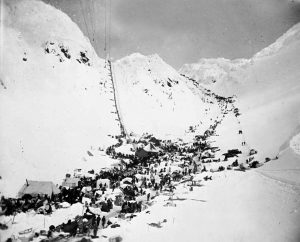 and family to travel up the Inside Passage to Skagway. They had gold on their minds, and the thought of going home rich was all they could think about. Most weren’t successful, and many didn’t make it there or back, but many went.
and family to travel up the Inside Passage to Skagway. They had gold on their minds, and the thought of going home rich was all they could think about. Most weren’t successful, and many didn’t make it there or back, but many went.
I don’t think this would be a trail I would want to be on in the winter, but it might be interesting in the summer months. There are many trails in the world that I would love to hike, but many of them I would probably only hike one time. I always find the history of the many trails that weren’t just for hiking originally, to be very interesting.

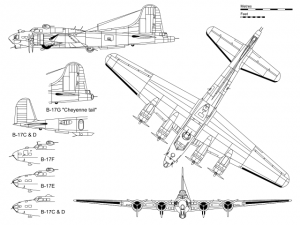 In World War II, my dad, Allen Spencer was the Flight Engineer and top turret gunner on a B-17. The B-17 was an amazing plane. Strategic bombing missions actually began at the tail end of World War I, And the big world powers knew that they needed to develop bomber fleets that could handle this new kind of bombing mission, because if they did not, they would be vulnerable to the evil nations who did develop such bombers. During the month of August 1934, in anticipation of rising tensions in the Pacific, the US Army Air Corps proposed a new multi-engine bomber that would replace the outdated Martin B-10. They put out the challenge and Boeing decided to get into the competition. The plan for this bomber was to provide reinforcement to bases in Hawaii, Alaska, and Panama.
In World War II, my dad, Allen Spencer was the Flight Engineer and top turret gunner on a B-17. The B-17 was an amazing plane. Strategic bombing missions actually began at the tail end of World War I, And the big world powers knew that they needed to develop bomber fleets that could handle this new kind of bombing mission, because if they did not, they would be vulnerable to the evil nations who did develop such bombers. During the month of August 1934, in anticipation of rising tensions in the Pacific, the US Army Air Corps proposed a new multi-engine bomber that would replace the outdated Martin B-10. They put out the challenge and Boeing decided to get into the competition. The plan for this bomber was to provide reinforcement to bases in Hawaii, Alaska, and Panama.
Enter the B-17 Flying Fortress. Boeing competed against both Martin and Douglas for the contract to build 200 units of such a bomber, but failed to deliver, as the first B-17 Flying Fortress crashed. Nevertheless, the Air Corps loved the design so much that they ordered 13 units for further evaluation and analysis. After a string of tests, it was introduced in 1938. The B-17 was now the prime bomber for all kinds of bombing raids. The prototype B-17 Bomber was built at the company’s own expense and was a fusion of the features of Boeing XB-15 and Boeing 247 Transport Aircraft. Initially, it could carry a payload of 4850 pounds along with 5x .30-inch machine guns. The 4x Hornet Radial Engines could produce 750 HP at 2100 meters. It was a tremendous machine. A reporter from the Seattle Times would nickname it The Flying Fortress…a name that stuck, even if he didn’t know how very accurate he was.
As World War II heated up, the attack on Pearl Harbor drew the United States into it, and the B-17 Flying 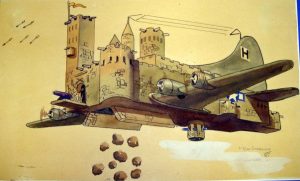
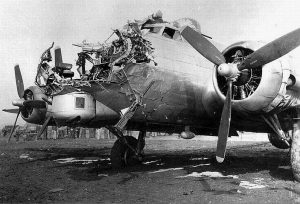 Fortress became a staple, used in every single World War II combat zone and by the time production ended in 1945. Boeing along with Douglas and Vega had built 12,731 bombers. When the US 8th Airforce arrived in England in 1942, their sole mission was to destroy Germany’s ability to wage war. They would use any means necessary, from carpet bombing to precision bombing. On August 17th, 1942, eighteen B-17s launched a bombing raid over Nazi-held territory in Europe, hitting railway networks and strategic points. The Luftwaffe was unprepared and didn’t know how to best attack the new planes, but it didn’t take long to improve their tactics. The B-17s suffered losses too. On September 6th, 1943, 400 bombers were sent out to attack a ball-bearing plant, 45 didn’t return. October 4th, 60 out of 291 B-17s sent to the same location were lost. January 11th, 1944, 600 B-17s were sent to various industries. Bad weather kept all but 238 of them on base. Still, 60 were lost. These losses were quite costly when you consider that a single B-17 Flying Fortress would cost $238,329 in 1945. The Luftwaffe quickly perfected their attacks on the B-17 Flying Fortress. Head on proved more fruitful and therefore the Americans developed the term “Bandits at 12 O’clock High” for oncoming Luftwaffe fighters.
Fortress became a staple, used in every single World War II combat zone and by the time production ended in 1945. Boeing along with Douglas and Vega had built 12,731 bombers. When the US 8th Airforce arrived in England in 1942, their sole mission was to destroy Germany’s ability to wage war. They would use any means necessary, from carpet bombing to precision bombing. On August 17th, 1942, eighteen B-17s launched a bombing raid over Nazi-held territory in Europe, hitting railway networks and strategic points. The Luftwaffe was unprepared and didn’t know how to best attack the new planes, but it didn’t take long to improve their tactics. The B-17s suffered losses too. On September 6th, 1943, 400 bombers were sent out to attack a ball-bearing plant, 45 didn’t return. October 4th, 60 out of 291 B-17s sent to the same location were lost. January 11th, 1944, 600 B-17s were sent to various industries. Bad weather kept all but 238 of them on base. Still, 60 were lost. These losses were quite costly when you consider that a single B-17 Flying Fortress would cost $238,329 in 1945. The Luftwaffe quickly perfected their attacks on the B-17 Flying Fortress. Head on proved more fruitful and therefore the Americans developed the term “Bandits at 12 O’clock High” for oncoming Luftwaffe fighters.
Various models of the B-17 Flying Fortress were produced, but the B-17G was the one that was most liked. Almost 9000 B-17Gs were produced, the most of any of the models, because of their superior specs. A B-17G weighed 65,000 pounds and could cruise at a speed of 150 miles per hour, peaking at 287 miles per hour. It could attain a service ceiling of 35,600 feet, and carry a 9600 pounds payload. The four Wright R-1820 Cyclone engines could produce 1200 horse power each! It was one rugged machine. One particular B-17 Bomber 
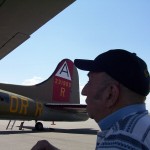 survived a bombing mission over Cologne, Germany, and flew back to safety with 180 flak holes and only 2 out of 4 engines in operation. The veteran never forgot, and 75 years later wrote a thank you letter to Boeing. He was thankful to be alive. My dad always felt that way too. Any amount of damage that happens to a plane can mean the difference between crashing and making it home. The B-17 was truly a flying fortress, and on of the best planes to be in. The chances of coming home were better than most.
survived a bombing mission over Cologne, Germany, and flew back to safety with 180 flak holes and only 2 out of 4 engines in operation. The veteran never forgot, and 75 years later wrote a thank you letter to Boeing. He was thankful to be alive. My dad always felt that way too. Any amount of damage that happens to a plane can mean the difference between crashing and making it home. The B-17 was truly a flying fortress, and on of the best planes to be in. The chances of coming home were better than most.

